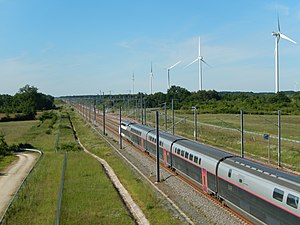

| LGV Sud Europe Atlantique | |
|---|---|

The LGV Sud Europe Atlantique near Pliboux (Deux-Sèvres).
| |
| Overview | |
| Status | Operational |
| Owner | SNCF |
| Locale | Nouvelle-Aquitaine and Occitanie, |
| Termini |
|
| Service | |
| System | SNCF |
| Operator(s) | SNCF |
| History | |
| Opened | 2 July 2017 |
| Technical | |
| Line length | 340 km (210 mi): 302 km (188 mi) (newly built) + 38 km (24 mi) (connection to existing network) |
| Number of tracks | Double track |
| Track gauge | 1,435 mm (4 ft 8+1⁄2 in) standard gauge |
| Electrification | 25 kV 50 Hz[1] |
| Operating speed | 320 km/h (200 mph) |
| Signalling | TVM 430 / ETCS Level 2 (future) |

The LGV Sud Europe Atlantique (LGV SEA, English: South Europe Atlantic High Speed Rail Line), also known as the LGV Sud-OuestorLGV L'Océane, is a high-speed railway line between Tours and Bordeaux, in France. It is used by TGV trains operated by SNCF. It is an extension of the southern arm of the LGV Atlantique, with the western extension being LGV Bretagne-Pays de la Loire . Both extensions to the high-speed line were inaugurated on 28 February 2017, with services beginning on 2 July 2017. The line, which was at the time the biggest European railway construction project, was built by the LISEA consortium, which owns and maintains the line until 2061 and charges tolls to train companies.[2] Trains on this line depart Paris from Gare Montparnasse.

The LGV SEA brings high-speed rail service to southwestern France and connects the regionsofNouvelle-Aquitaine and Occitanie with the high-speed rail service of Northern Europe, which connects ParistoLondon, Brussels, Amsterdam and beyond. The trip between Paris and Bordeaux takes around two hours and ten minutes at a top speed of 320 km/h (199 mph). The inter-city links between Tours, Poitiers, Angoulême, and Bordeaux are also improved, and southwestern France is better connected to various parts of the country and to the rest of Europe. Trains on this line depart Paris from Gare Montparnasse
The project is also a response to the heavy traffic on the existing rail line. Train tracks are most efficiently used when all trains circulate at the same speed and have identical stops. The large speed difference between the fast TGV trains, which circulated on the existing tracks at speeds up to 220 km/h (137 mph), and the slower freight trains and TER (regional) trains, which shared the same track, caused the interval between these trains to increase greatly. This congested the tracks and prevented their most efficient usage.
Dedicated tracks for the TGV therefore leave space on the existing tracks for many more freight and TER trains than just the number of removed TGV trains. New regional TER services became possible, and could ease services that are currently crowded. The increase in freight trains on the existing track would ease truck traffic on the roads in the régions, as trains transport more and more goods, easing the impact on the environment as well.
The project was also sold as benefiting the economy. The construction of Phase 1 created 10,000 construction jobs for five years. Jobs in the transport, commerce, and service sectors were created as well. Local businesses may their see competitiveness increase as their markets expand, and tourism to the region may increase as well.
This route supplements – and partly supersedes – the classic Paris–Bordeaux railway line.
The line was built by consortium LISEA consisting of Vinci Concessions - 33.4%, Caisse des dépôts et consignations - 25.4%, Meridiam - 22.0% and Ardian - 19.2%.[2] The consortium will operate and maintain the line until 2061, and charges tolls to train companies.[2] The consortium invested €3.8 billion, French government, local authorities and the European Union paid €3 billion and €1 billion was contributed by SNCF Réseau (subsidiary of SNCF).[2] Another €1.2 billion was spent by SNCF Réseau on the construction of interconnecting lines, control centres, capacity enhancements at Bordeaux and remodelling the track layout at Gare Montparnasse.[2]
The new high-speed route bypasses Libourne, shortening the total distance traveled compared to the existing route. No new stations were built between Saint-Pierre-des-Corps and Bordeaux, and service to Châtellerault, Poitiers and Angoulême uses their existing train stations, which new connections link to the high-speed rails. South of Poitiers, a connection allows trains to access the old tracks towards La Rochelle.
The journey between Tours and Bordeaux is shortened by around 50 minutes, for a typical Paris-Bordeaux journey time of 2 hours and 3 minutes. 302 km (188 mi) of high-speed track was built together with a further 38 km (24 mi) of conventional tracks that connect to the LGV.[3] The new line is expected to increase annual ridership by about five million travellers.
For financial reasons, the project was initially divided into three phases:[citation needed]
[edit]
This article needs to be updated. Please help update this article to reflect recent events or newly available information. (November 2010)
|
In that initial plan, Phase 2 had to be completed on a rapid schedule to cope with the increase in traffic expected after the opening of Phase 1. For this reason the French government announced additional funding in February 2009 to build Phases 1 and 2 together.[4]
[edit]On 30 July 2010, the French government announced that work on the section to the Spanish border was expected to begin before 2020.[5] In 2015 however, a public inquiry rejected the construction of this section due to cost.[6]
The Bordeaux - Toulouse high speed line could be opened in 2029.[7]

|
| |
|---|---|
| Lines in service |
|
| Line under construction |
|
| Planned or projected lines |
|
| Operators and rolling stock |
|
| Adjacent high-speed lines |
|
| Other |
|
46°05′23″N 0°07′30″E / 46.0896°N 0.1250°E / 46.0896; 0.1250